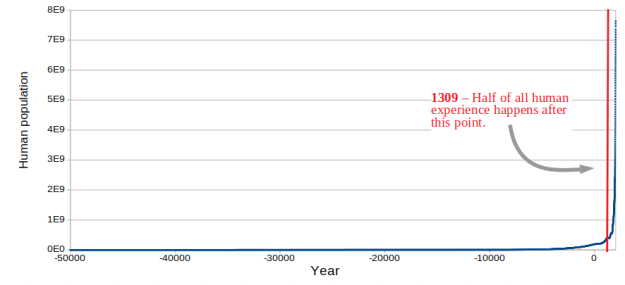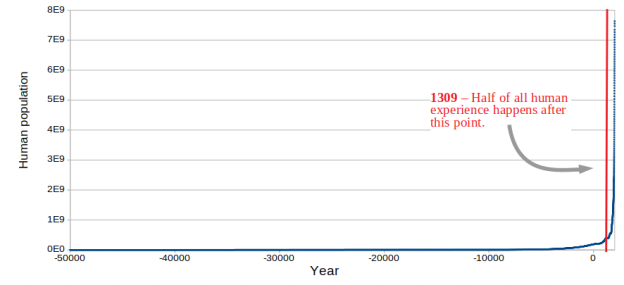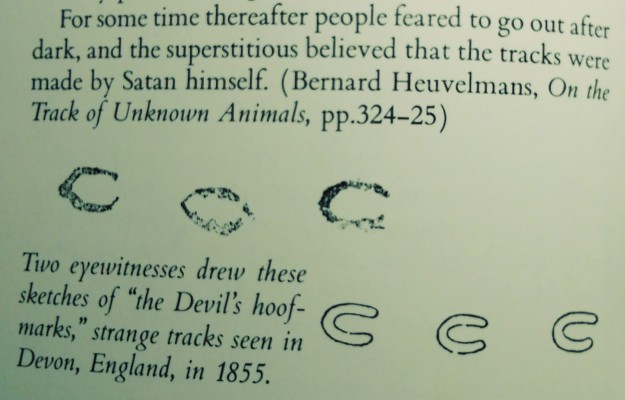[EDIT: Previous version of this post had some errors. Thanks for jeff8765 for pinpointing the error and esrogs in the comments for bringing it to my attention as well. This has been fixed. Also, I wrote FHI when I meant FLI.]
The graph of the human population over time is also a map of human experience. Think of each year as being “amount of human lived experience that happened this year.” On the left, we see the approximate dawn of the modern human species in 50,000 BC. On the right, the population exploding in the present day.

It turns out that if you add up all these years, 50% of human experience has happened after 1309 AD. 15% of all experience has been experienced by people who are alive right now.
I call this “the funnel of human experience” – the fact that because of a tiny initial population blossoming out into a huge modern population, more of human experience has happened recently than time would suggest.
50,000 years is a long time, but 8,000,000,000 people is a lot of people.

Early human experience: casts of the skulls of the earliest modern humans found in various continents. Display at the Smithsonian Museum of National History.
If you want to expand on this, you can start doing some Fermi estimates. We as a species have spent…
- 1,650,000,000,000 total “human experience years”
- See my dataset linked at the bottom of this post.
- 7,450,000,000 human years spent having sex
- Humans spend 0.45% of our lives having sex. 0.45% * [total human experience years] = 7E9 years
- 52,000,000,000 years spent drinking coffee
- 500 billion cups of coffee drunk this year x 15 minutes to drink each cup x 100 years* = 5E10 years
- *Coffee consumption has likely been much higher recently than historically, but it does have a long history. I’m estimating about a hundred years of current consumption for total global consumption ever.
- 1,000,000,000 years spent in labor
- 110,000,000,000 billion humans ever x ½ women x 12 pregnancies* x 15 hours apiece = 1.1E9 years
- *Infant mortality, yo. H/t Ellie and Shaw for this estimate.
- 417,000,000 years spent worshipping the Greek gods
- 1000 years* x 10,000,000 people** x 365 days a year x 1 hour a day*** = 4E8 years
- *Some googling suggested that people worshipped the Greek/Roman Gods in some capacity from roughly 500 BC to 500 AD.
- **There were about 10 million people in Ancient Greece. This probably tapered a lot to the beginning and end of that period, but on the other hand worship must have been more widespread than just Greece, and there have been pagans and Hellenists worshiping since then.
- ***Worshiping generally took about an hour a day on average, figuring in priests and festivals? Sure.
- 30,000,000 years spent watching Netflix
- 14,000,000 hours/day* x 365 days x 5 years** = 2.92E7 years
- * Netflix users watched an average of 14 million hours of content a day in 2017.
- **Netflix the company has been around for 10 years, but has gotten bigger recently.
- 50,000 years spent drinking coffee in Waffle House
- 1.3 million cups* x 20 minutes = 4.9E4 years
So humanity in aggregate has spent about ten times as long worshiping the Greek gods as we’ve spent watching Netflix.
We’ve spent another ten times as long having sex as we’ve spent worshipping the Greek gods.
And we’ve spent ten times as long drinking coffee as we’ve spent having sex.
I’m not sure what this implies. Here are a few things I gathered from this:
1) I used to be annoyed at my high school world history classes for spending so much time on medieval history and after, when there was, you know, all of history before that too. Obviously there are other reasons for this – Eurocentrism, the fact that more recent events have clearer ramifications today – but to some degree this is in fact accurately reflecting how much history there is.
On the other hand, I spent a bunch of time in school learning about the Greek Gods, a tiny chunk of time learning about labor, and virtually no time learning about coffee. This is another disappointing trend in the way history is approached and taught, focusing on a series of major events rather than the day-to-day life of people.
2) The Funnel gets more stark the closer you move to the present day. Look at science. FLI reports that 90% of PhDs that have ever lived are alive right now. That means most of all scientific thought is happening in parallel rather than sequentially.
3) You can’t use the Funnel to reason about everything. For instance, you can’t use it to reason about extended evolutionary processes. Evolution is necessarily cumulative. It works on the unit of generations, not individuals. (You can make some inferences about evolution – for instance, the likelihood of any particular mutation occurring increases when there are more individuals to mutate – but evolution still has the same number of generations to work with, no matter how large each generation is.)
4) This made me think about the phrase “living memory”. The world’s oldest living person is Kane Tanaka, who was born in 1903. 28% of the entirety of human experience has happened since her birth. As mentioned above, 15% has been directly experienced by living people. We have writing and communication and memory, so we have a flawed channel by which to inherit information, and experiences in a sense. But humans as a species can only directly remember as far back as 1903.
Here’s my dataset. The population data comes from the Population Review Bureau and their report on how many humans ever lived, and from Our World In Data. Let me know if you get anything from this.
Fun fact: The average living human is 30.4 years old.
Wait But Why’s explanation of the real revolution of artificial intelligence is relevant and worth reading. See also Luke Muehlhauser’s conclusions on the Industrial Revolution: Part One and Part Two.
Crossposted to LessWrong.





